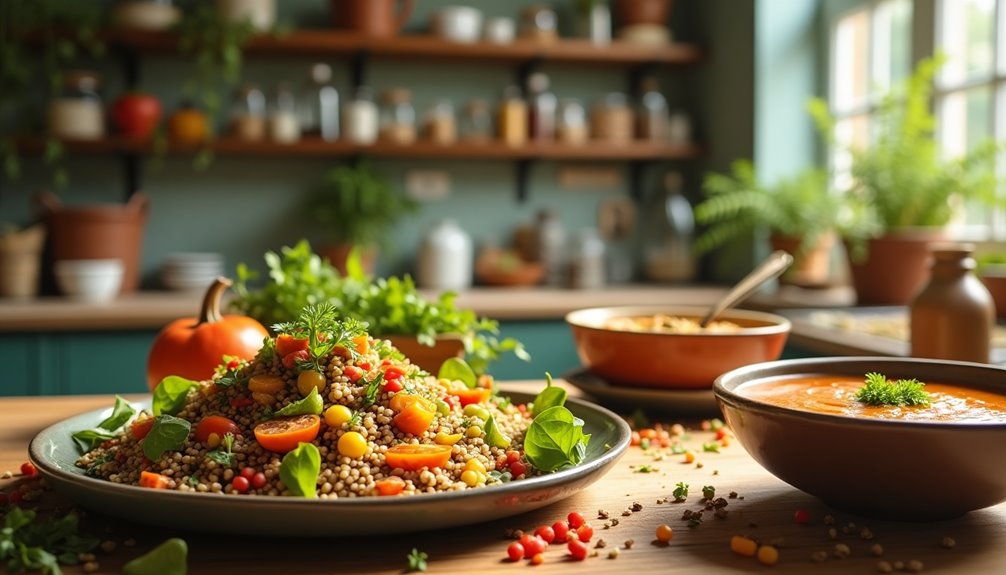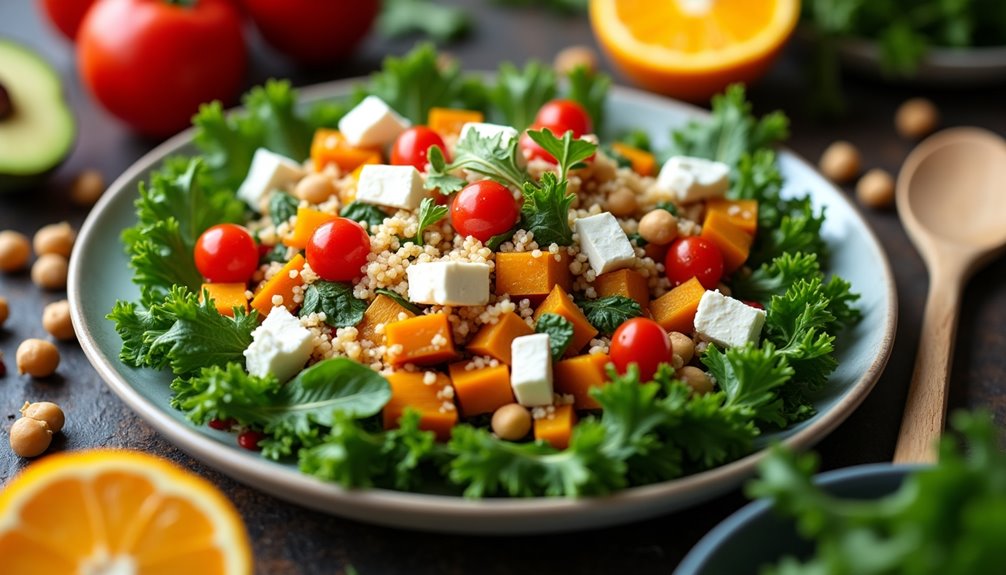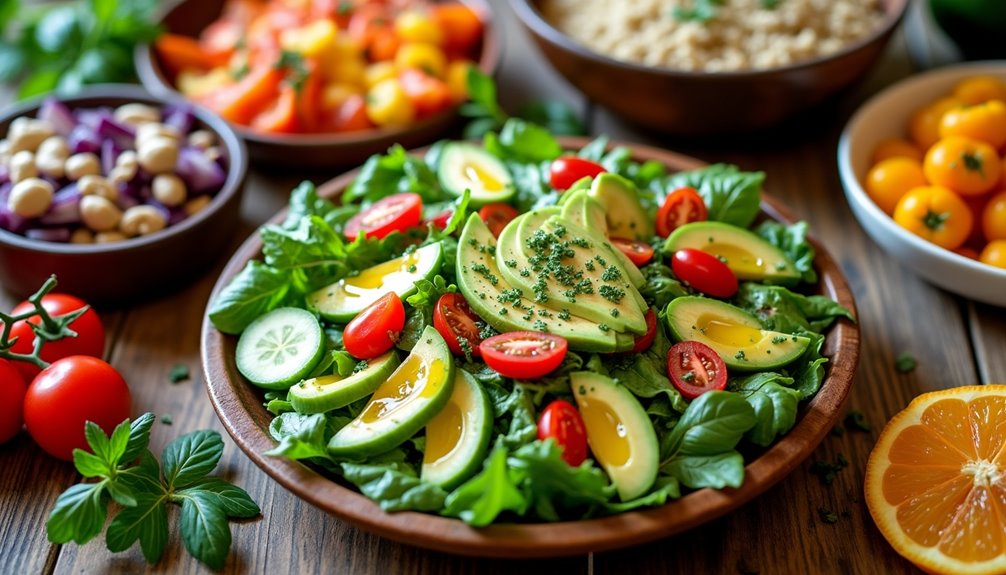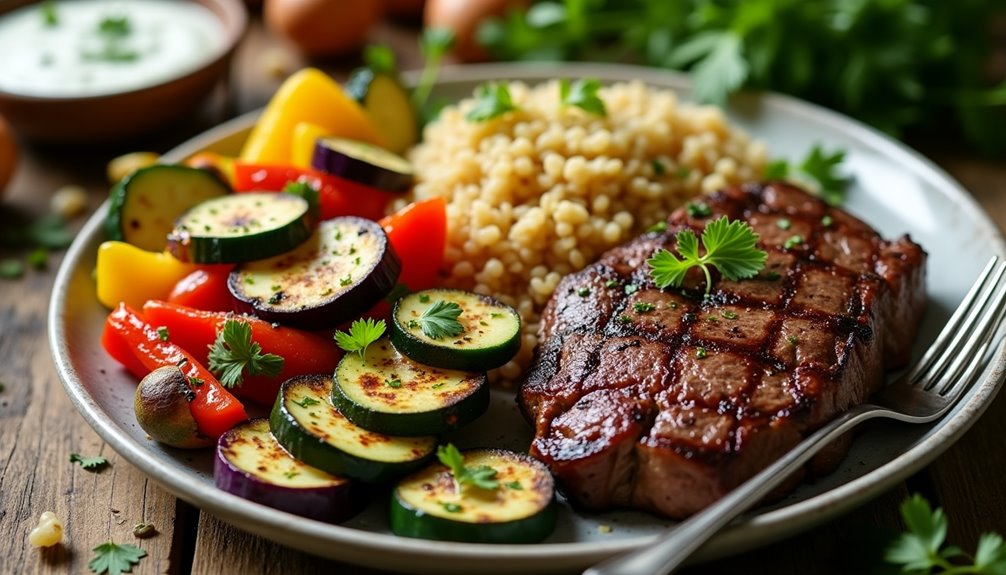The flexitarian eating plan blends the concepts of plant-based nutrition with occasional meat intake, providing adaptability without rigid guidelines. It emphasizes natural foods, promotes balance, and can assist in weight control while improving your general well-being. By emphasizing fresh, seasonal produce and plant-based proteins, you'll encounter a variety of meal choices that please your palate. This method enables you to reap the advantages of a vegetarian diet while still enjoying meat occasionally, simplifying the shift. Furthermore, it nurtures a feeling of camaraderie regarding mindful eating practices. Discover ways to seamlessly incorporate this approach into your daily routine.
Key Takeaways
- The flexitarian diet emphasizes a primarily plant-based approach while allowing occasional meat and animal products for nutritional balance.
- It encourages whole foods, moderation, and conscious eating habits, promoting overall health and sustainability.
- Transitioning to a flexitarian lifestyle can begin with simple steps like "Meatless Mondays" or replacing one meal a day with plant-based options.
- Flexitarian diets provide a more approachable way to reduce meat consumption compared to strict vegetarian diets, offering greater flexibility.
- Meal ideas include plant-based breakfasts, veggie stir-fries, and roasted vegetable dishes, making it easy to enjoy diverse and delicious meals.
What Is a Flexitarian Diet?

A flexitarian diet, combining flexibility and vegetarian principles, encourages you to embrace a primarily plant-based eating style while still allowing for occasional meat and animal products. This approach offers dietary balance, letting you enjoy the benefits of vegetables, fruits, whole grains, and legumes without completely sacrificing your favorite meals that include meat.
By adopting flexitarian adaptability, you can tailor your eating habits to suit your lifestyle and preferences. This means you can enjoy a hearty vegetable stir-fry one day and a grilled chicken salad the next, all while prioritizing plant-based foods. This balance not only supports your health but also reflects ethical choices regarding food sourcing and consumption.
Moreover, a flexitarian diet can notably reduce your environmental impact. Studies show that cutting back on meat, even just a few days a week, can lower greenhouse gas emissions and conserve natural resources. By consciously choosing when and how much animal product to include, you're participating in a more sustainable food system. Additionally, adopting a flexitarian approach can still provide you with significant health benefits associated with a plant-based diet.
The beauty of a flexitarian diet lies in its inclusivity. You won't feel pressured to conform strictly to vegetarianism or veganism. Instead, you'll find a supportive community of like-minded individuals who appreciate the shared journey toward healthier eating and a more responsible lifestyle. Embracing this approach can help you feel a sense of belonging while making choices that are good for both you and the planet.
Key Principles of Flexitarian Eating

At its core, flexitarian eating revolves around several key principles that promote a balanced approach to nutrition. Embracing a flexitarian mindset means you're open to incorporating more plant-based foods into your meals while still enjoying the occasional animal product. This flexibility allows you to find what works best for your lifestyle, making it easier to stick with your dietary choices.
One of the fundamental principles is prioritizing whole foods. Focus on fruits, vegetables, whole grains, legumes, nuts, and seeds. These nutrient-dense foods not only nourish your body but also support mental well-being. When you fill your plate with colorful, whole ingredients, you're choosing a balanced approach that benefits both your health and the planet.
Another key aspect is moderation. You don't have to eliminate meat entirely; instead, consider reducing your consumption gradually. This could look like participating in "Meatless Mondays" or replacing meat with plant-based proteins in your favorite recipes. By doing so, you can still enjoy the flavors you love while diversifying your diet.
Additionally, listen to your body and adjust your meals based on your unique needs. Flexitarian eating encourages mindfulness around food choices, which fosters a sense of community and connection with others who share similar values. Ultimately, it's about finding that sweet spot where you can enjoy diverse foods while maintaining a balanced approach to health. Embrace the journey, and enjoy the delicious possibilities that flexitarian eating offers! Moreover, incorporating more whole food sources of protein into your meals can enhance your energy levels and support your overall health.
Health Benefits of a Flexitarian Diet

Embracing a flexitarian diet not only enhances your eating experience but also offers numerous health benefits. This dietary approach emphasizes plant-based foods while allowing for occasional meat consumption, giving you the flexibility to enjoy a variety of flavors and nutrients. Research shows that by prioritizing fruits, vegetables, whole grains, and legumes, you can improve your overall health.
One of the most significant benefits of a flexitarian diet is weight management. Studies indicate that individuals who adopt this eating style tend to consume fewer calories and maintain healthier body weights compared to those on more restrictive diets. The focus on nutrient-dense foods helps you feel satisfied while keeping your caloric intake in check.
In addition, a flexitarian diet can play a pivotal role in disease prevention. By increasing your intake of plant-based foods, you lower your risk of chronic diseases such as heart disease, diabetes, and certain cancers. The antioxidants and fiber found in fruits and vegetables contribute to better heart health and improved digestion. Furthermore, adopting a flexitarian diet can lead to longer, healthier lives as it incorporates more plant-based options, similar to the benefits of veganism.
The beauty of the flexitarian approach lies in its flexibility. You're not forced into a rigid diet; instead, you can explore a rich variety of meals that cater to your taste preferences. This makes it easier to maintain a sustainable eating pattern that fits your lifestyle. Overall, adopting a flexitarian diet not only enriches your palate but also supports your health goals, fostering a sense of community as you share delicious, wholesome meals with others.
Flexitarian vs. Vegetarian Diets

When comparing flexitarian and vegetarian diets, it's crucial to recognize the key differences that can influence your eating choices and lifestyle. Flexitarian diets emphasize dietary flexibility, allowing you to enjoy plant-based foods while occasionally incorporating meat or fish. This approach can make the shift to a more plant-centric diet less challenging, especially if you're used to a more omnivorous lifestyle.
On the other hand, vegetarian diets strictly exclude meat and fish. This commitment often stems from ethical considerations, as many choose vegetarianism to reduce animal suffering and promote sustainable farming practices. While both diets can support a nourishing lifestyle, a flexitarian diet may offer greater nutritional balance, as it allows for more diverse food choices. You can easily include essential nutrients found in animal products while focusing on whole grains, legumes, fruits, and vegetables.
From an environmental impact perspective, both diets contribute positively compared to a standard omnivorous diet. However, the flexitarian approach can be more approachable for those who want to gradually reduce their meat consumption without fully committing to vegetarianism. This adaptability can foster a sense of community and belonging among friends and family, making it easier to enjoy meals together. Additionally, incorporating custom keto diet plans can further enhance your nutritional intake and support your health journey. Ultimately, whether you choose a flexitarian or vegetarian diet depends on your personal values, lifestyle, and health goals. Both paths can lead to a healthier, more sustainable way of eating.
Tips for Transitioning to Flexitarian

Shifting towards a flexitarian diet can be an exciting journey that enhances your meals while still allowing for some of your favorite animal products. To make this switch smoother, start by incorporating flexitarian budgeting into your meal planning. This means being mindful of your grocery expenses while prioritizing plant-based ingredients.
Focus on seasonal produce and bulk items like grains and legumes, which are both economical and nutritious.
Next, explore various flexitarian recipes to inspire you. Look for cookbooks that focus on plant-forward meals, such as "Plenty" by Yotam Ottolenghi or "Thug Kitchen" for a more playful approach. These resources will provide a wealth of ideas that ease you into cooking with more vegetables and plant proteins.
You don't have to go all-in at once. Consider starting with "Meatless Mondays" or replacing one meal a day with a plant-based option. This gradual shift helps your palate adjust while allowing you to discover which recipes resonate with you.
Don't forget about the community aspect of this journey. Join online forums or local groups where you can share your experiences and swap flexitarian recipes. Having a support system can make the switch more enjoyable and fulfilling. Additionally, embracing a variety of delicious plant-based recipes can help maintain excitement in your meal planning.
Meal Ideas for Flexitarian Lifestyle

A variety of meal ideas can keep your flexitarian lifestyle both satisfying and flavorful. Start your day with delicious plant-based breakfasts that fuel you for whatever lies ahead. Think oatmeal topped with fresh fruits and nuts or a smoothie packed with spinach, banana, and almond milk. These options aren't only nutritious but also easy to whip up during your morning routine.
As you navigate through the week, flexitarian meal prep can be a lifesaver. Prepare a big batch of quinoa or brown rice, which can serve as a base for several meals. Pair it with roasted vegetables and chickpeas for a hearty lunch or dinner. You can also create a hearty vegetable soup or a lentil stew that holds up well in the fridge for quick meals.
When it comes to meatless dinners, consider trying a veggie stir-fry with tofu and a mix of colorful vegetables, or pasta tossed with seasonal veggies and a light garlic sauce. These dishes can satisfy your cravings while incorporating plenty of plant-based goodness. Additionally, incorporating fat-melting smoothie recipes into your routine can provide an easy and delicious way to enhance your diet.
Don't forget, dining out can also be enjoyable! Many restaurants now offer flexitarian-friendly options. Look for meals that highlight vegetables, whole grains, and legumes, ensuring you stay aligned with your dietary goals while enjoying social gatherings. Embracing these meal ideas won't only enhance your culinary experience but also help you feel connected to a community that values delicious, sustainable eating.
Addressing Common Misconceptions

Many people have misconceptions about the flexitarian diet, often viewing it as a half-hearted attempt at vegetarianism. In reality, the flexitarian approach emphasizes flexitarian flexibility, allowing you to adopt a more plant-based lifestyle while still enjoying meat and animal products in moderation. This isn't just a casual way to eat; it's a deliberate choice aimed at improving health and sustainability.
One common misconception is that being flexitarian means you have to cut out meat entirely. This isn't true. Flexitarianism encourages you to increase your intake of fruits, vegetables, whole grains, and legumes, while still enjoying your favorite meats occasionally. This makes it accessible for those who may not be ready to commit fully to vegetarianism or veganism.
Another myth is that a flexitarian diet lacks protein. On the contrary, by incorporating plant-based proteins like beans, lentils, and tofu, along with moderate portions of meat, you can meet your protein needs effectively.
Additionally, some think that being flexitarian is just a trend. However, research shows that adopting this dietary style can lead to numerous health benefits, such as weight management and reduced risk of chronic diseases. Embracing a natural calorie cycle can further enhance the effectiveness of a flexitarian diet, promoting overall health and vitality.
Ultimately, the flexitarian diet fosters a sense of belonging to a community focused on health, sustainability, and conscious eating. So, if you're looking for a balanced way to enjoy food without strict rules, flexitarianism might just be the right fit for you. Embrace the flexibility and find what works best for your lifestyle!
Frequently Asked Questions
Can I Still Eat Dairy and Eggs on a Flexitarian Diet?
Yes, you can still enjoy dairy and eggs! Many people include these foods while balancing their diets. If you're looking to reduce dairy, consider dairy alternatives like almond or oat milk.
For eggs, egg substitutes such as flaxseed or tofu can work great in various recipes. This way, you can still savor your favorites while exploring new options. It's all about finding what feels right for you and your lifestyle!
How Does a Flexitarian Diet Impact Weight Loss Efforts?
A balanced diet can greatly impact your weight loss efforts. By focusing on whole foods and incorporating an exercise routine, you'll likely find it easier to shed pounds.
Portion control plays an essential role, as it helps you manage calorie intake while still enjoying a variety of foods.
Combining these elements can create a sustainable approach to weight loss, fostering a sense of community with others on similar journeys, making your goals feel more attainable.
Are There Any Specific Supplements Needed for a Flexitarian Diet?
When considering a balanced diet, you might wonder if you need specific supplements. Focus on incorporating diverse protein sources, like legumes, nuts, and dairy, to [GUARANTEE] you're meeting your protein needs.
Additionally, pay attention to nutrient balance, especially B12 and omega-3 fatty acids, which can be lacking in some plant-based diets.
It's always a good idea to consult with a healthcare provider to personalize your supplement needs based on your dietary choices.
Is the Flexitarian Diet Suitable for Children and Pregnant Women?
Wondering if a certain diet can meet the nutritional needs of children and pregnant women? You're not alone. Both groups have unique requirements that can be met with careful planning.
For children, focus on balanced meals that support growth, while pregnant women need to maximize nutrient absorption for the baby's development. Consulting a healthcare professional can help tailor the diet to their specific needs, guaranteeing everyone stays healthy and nourished.
How Do I Handle Dining Out While Following a Flexitarian Diet?
When dining out, you can handle your meal choices by planning ahead. Start with meal prep ideas that fit your preferences.
Look for restaurants that offer a variety of vegetarian and plant-based options. Many places now cater to different diets, so don't hesitate to ask for modifications.
You can enjoy socializing while still sticking to your goals. Remember, it's all about balance, so indulge occasionally without guilt.
Enjoy your meals!
Conclusion
Integrating a flexitarian diet into your lifestyle can feel like stepping into a world of culinary possibilities, much like a modern-day Odyssey for your taste buds. By embracing flexibility and balance, you're not just enhancing your health; you're also enjoying delicious meals that nourish your body. Remember, it's not about perfection but progress, allowing you to savor the best of both worlds. So, why not set off on this flavorful journey and discover the benefits waiting for you?



